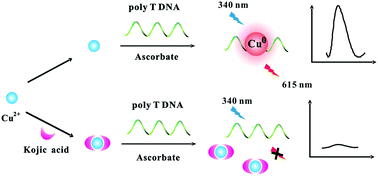Blocking the formation of fluorescent poly(thymine)-templated copper nanoparticles for label-free and sensitive detection of kojic acid in foodstuffs
Abstract
In this paper, a simple, rapid and label-free fluorescent sensor has been developed for the detection of kojic acid based on the kojic acid-induced blocking of the formation of poly(thymine) (poly T)-templated copper nanoparticles (Cu NPs). In the presence of kojic acid, the fluorescence intensity decreased significantly owing to the strong complexation interaction between Cu2+ and kojic acid, which hampered the effective formation of fluorescent poly T-templated Cu NPs. Under the optimized conditions, the fluorescent sensor exhibited sensitive and selective detection of kojic acid with a linear range from 0.1 μM to 300 μM and a detection limit of 30 nM. Furthermore, the method was successfully applied for the detection of kojic acid in foodstuff samples. In addition, this method was low-cost, convenient and highly selective, and the whole procedure could easily be accomplished within 10 minutes at room temperature. Therefore, it could hold considerable potential for constructing a simple, rapid and sensitive fluorescent platform for the detection of kojic acid.


 Please wait while we load your content...
Please wait while we load your content...